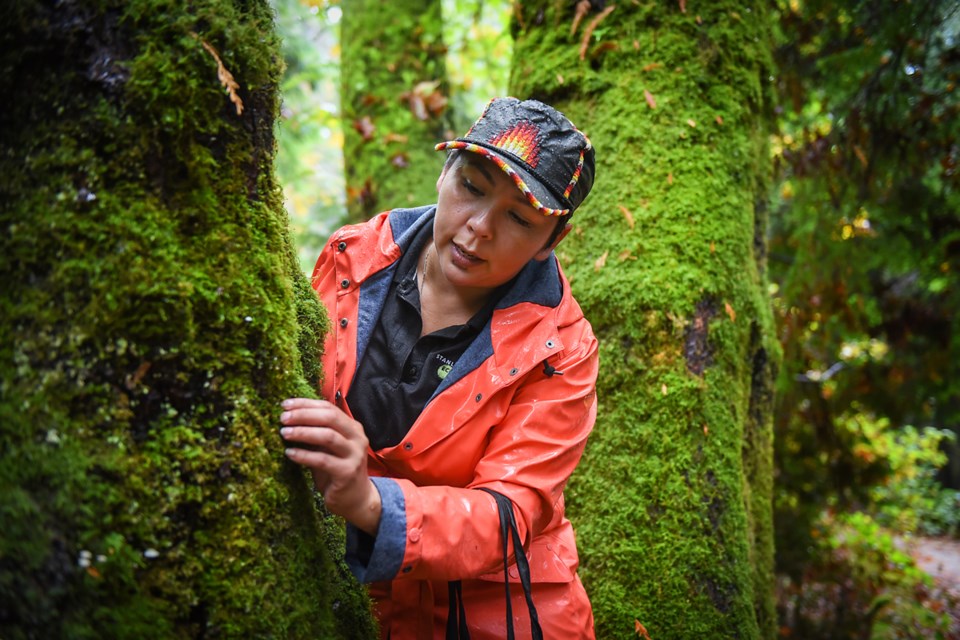The most effective way to teach is by showing. For Lauraleigh Paul Yuxweluptun’aat, it’s also the only way.
Paul is an environmental educator with the Stanley Park Ecology Society (SPES), which was so pleased to have the Coast Salish, Interior Salish and Carrier First Nations woman on staff as of last spring, they wasted no time designing a curriculum around her expertise. Paul led Indigenous-based walking tours through the park in late August and Saturday was her first workshop with the society to teach traditional medicine.
Before any students arrived, she ducked out of the classroom on the top floor of the Stanley Park Dining Pavilion and walked into a nearby clearing. It was just steps away from the parking lot, a two-minute drive from the city, but the only sound in the forest, which was once home to Indigenous villages, was rain splashing on leaves.
Paul crouched to pick up a ubiquitous green weed, otherwise known as frog leaf (common plantain). She explained its physical characteristics (“wrinkly like the back of a frog and the shape like the bum of a frog”) and stopped. Paul wanted to make sure the Courier wouldn’t publish the details of the medicinal remedies she was to teach as she felt it would be reckless and possibly harmful to readers who might pick the wrong plant.
“It’s really important that traditional knowledge be passed on traditionally and that’s person to person,” she said. “That allows for people to connect to the lessons that are valuable to them. The spirit actually attaches to it because they’re so present… It could have been told to me over and over again, but if I wasn’t present and open, I wouldn’t have the information. I would not have made practice of it.”
Paul’s grandmother taught her traditional medicine remedies when she was a little girl. Now, she passes on her ancestor’s ancient knowledge to two sons Talon and Koyas, as well as those who signed up for the West Coast Wild Remedies workshop where some of the students were familiar faces, having attended her summer walking tour.
The workshop examines uses of frog leaf: fresh, it can be used much like an antibiotic ointment for scratches, insect stings and bites. Paul, who is allergic to bee stings, was once stung and did not have her EpiPen. She grabbed a handful of frog leaf, chewed it, and held it to the affected area.
“And that had absorbed enough of the toxin from the bee sting that I didn’t go into anaphylactic shock,” she said. “By the time I got to the hospital, I was still OK. Still alive and breathing. Swollen and frantically panicked but, otherwise, good to go.”
Ingested as a tea, frog leaf is said to be an anti-inflammatory and wonderful to aid in general healing, as well as help with menstrual cramps, Paul added.
“It’s such a multifunctional leaf and people consider it just a weed.”
After making a frog leaf salve, Paul’s students followed their energetic leader into the park to a particular moss-coated tree that bent low over a forest path. Paul climbed its trunk to carefully harvest a single licorice root (glycyrrhiza glabra).
She broke it into pieces and handed them out for people to taste the strong licorice flavour of the herbal medicine said to be good for a wide variety of ailments ranging from easing sore throats to contributing to a healthy heart.
Paul’s wealth of knowledge when it comes to native medicines found in Stanley Park is incredible to newbies. But for her it’s so traditional it’s common sense.
“I’m no means an expert,” she said. “I’m just happy to share my knowledge.”
The next West Coast Wild Remedies workshop is Oct. 22 and focuses on smudging with cedar to kill airborne bacteria, and making a blue elderberry tincture for immune system boosting. Visit stanleyparkecology.ca for registration and events.
[email protected]
@rebeccablissett


